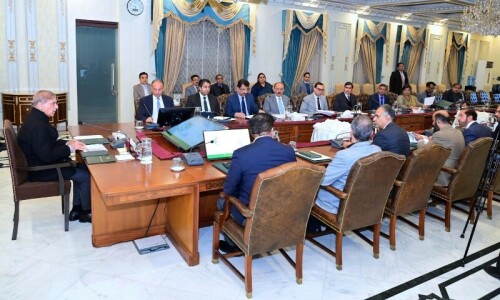Punjab’s budget for 2019-20 evidently anticipates a significant shortfall in the collection of the targeted tax revenues of Rs5550 billion by the Federal Board of Revenue (FBR). This in turn would lead to a significant reduction in its projected share of Rs1,601.5bn, depicting a growth of 25 per cent year-on-year, from the federal divisible pool.
The provincial government’s suspicions about the FBR’s ability to achieve its target are concealed in various places in its next budget. It has, for example, made very conservative allocations for both current and development spending in spite of a fifth growth in its total projected income (exclusive of the Rs208bn food account but inclusive of foreign loans and recoveries of Rs102.5bn) from the original estimates of Rs1.747 trillion for this fiscal year to Rs2.092tr for the next fiscal year.
The projected income in the next budget is over 35pc higher than the revised estimates for the present year. The current expenditure is raised by a modest 2.7pc to Rs1.299tr and development allocations by 47pc to Rs350bn (including foreign project assistance in excess of Rs18bn).
Additionally, the provincial finance managers have cleverly parked a big portion of “excess money”, which it expects to never receive unless the FBR collects the targeted tax, in bloated allocations for the capitalisation of the provincial pension fund and for disbursement of loans to the government employees and non-banking financial institutions.
The provincial government’s suspicions about the FBR’s ability to achieve its target are concealed in various places in its next budget
The allocation for investment in pension fund has been increased to Rs84.4bn from Rs36.3bn and for disbursement of loans to Rs76.9bn from Rs20.2bn. These are the areas where it will be easier for the government to revise down its estimates in case of lower than projected federal transfers at the end of the fiscal year without attracting any political backlash or public criticism.
That’s not all; the government has also pledged to run a cash surplus of slightly more than Rs233bn or equal to half a percent of the GDP to meet a federal requirement provided the FBR achieves its target and the province receives the promised cash from the divisible pool.
It had vowed to produce a surplus of Rs147.8bn this year but has instead showed a deficit of Rs25.1bn owing to huge shortfall in the FBR tax collection and subsequent much lower-than-projected federal transfers to the provinces from the divisible pool.
The provincial government’s apprehensions about the ability of the FBR to collect the targeted tax are not misplaced. The revised estimate for the present financial year show that Punjab will receive Rs1.197tr or 6.2pc less than the projected federal transfers of Rs1.276tr from the tax divisible pool.
If an amount of Rs122bn that the federal government withheld from Punjab’s share in 2017-18 and released during this fiscal is also excluded from the revised estimates, the shortfall from the pool will rise by 15.7pc to Rs1,075.3bn at the end of the current year.
PROVINCIAL TAXES: The Punjab government was widely expected to significantly increase its provincial tax revenues to make up for possible losses in federal taxes and create space for higher development spending for pushing economic growth to 7pc in the last year of its term in power as enunciated in its Punjab Growth Strategy 2023.
However, the finance bill shows that it has been content to mobilise around Rs11bn as additional tax income to increase the provincial tax target by 6.9pc to Rs294.9bn next year through changes and modifications in the property, sales tax on services and agriculture income regimes.
Although the changes in the agriculture income tax regime are expected to produce additional tax of Rs900m next year, the government has failed to align the tax slabs on income from agriculture with the federal income tax rates to create tax equity. It means the large farmers will pay less tax than salaried persons or associations of persons earning the same amount a year.
Officials explain that the province does not expect a rapid growth in taxes this year because of the economic slowdown as the federal government has embarked upon an economic stabilisation agenda to contract both public and private demand. The reduced growth rate this year is held responsible for the failure of the provincial tax agencies to meet their collective target of Rs275.8bn by almost a quarter.
The government of Chief Minister Usman Buzdar has set aside Rs350bn for development investment next year — or Rs100bn less than the planned spending of Rs450bn under its growth strategy on the back of anticipated reduction in its projected share from the federal taxes and the low provincial tax contribution.
But finance minister Makhdum Hashim Jawan Bakht said at the post budget press conference that the PTI administration planned to make up for the “low resource availability” for development by attracting private investment of Rs42bn in low-hanging infrastructure projects in the province. But will private businessmen want to invest such projects in a slowing economy? That is a question.
Nevertheless, the development allocations are clearly indicative of the shift in the provincial government’s development policy paradigm. Rather than pursuing capital-intensive large infrastructure projects as has been the case during the last 10 years, the incumbents have chosen to focus on human resource development through significant investments in social sector to improve and expand geographical scope of healthcare, education and other public services.
Moreover, it has promised to protect the uplift expenditure for South Punjab and prevent its re-appropriation for projects in other parts of the province. This step should help bridge the massive development gaps between the poorer and the wealthier districts of the province. —NJ
Published in Dawn, The Business and Finance Weekly, June 24th, 2019














































